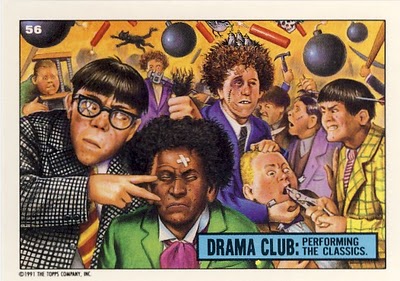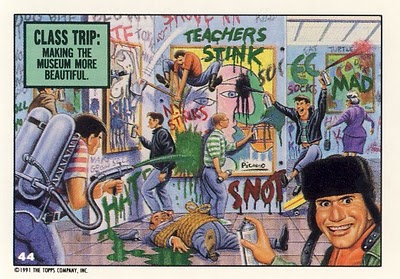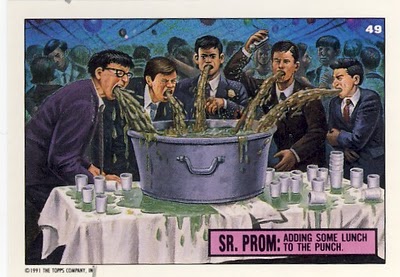Toxic High: The Last Hurrah!
By Kurt Kuersteiner © 2008 Monsterwax Monster Trading Cards
When I think back to the impact of gum cards on my youth, I often remember the trouble they got me into at school. Whenever the teachers found stickers of Odd Rods plastered on desks, lockers, or bathroom walls, they always knew whom to punish. I also got in hot water for selling the darn things at ten times their retail during lunch to suckers (I mean, fellow collectors). There was something insidious about those grotesque images that were contagious to kids, undermining their respect for authority and society in general. The card companies denied this the same way tobacco companies denied smoking was addictive, but secretly, both industries knew the reverse was true. The tobacco folks added nicotine to boost sales, and likewise, card companies increased the sarcasm and gross factor to better hook kids.
With all this in mind, it was only a matter of time before trading card companies went from subtle attacks on authority to a direct frontal assault. In 1991, Topps took the plunge and did what every red blooded American boy dreamed but dared not do--they declared war on school. And thus, Toxic High was born!
Now to be fair, Topps wasn't actually the first to devote a series attacking the institution of learning. Fleer produced Grossville High in 1987. But Grossville is to Toxic as Armenia is to America: So insignificant as to make a comparison laughable. Grossville was just mediocre but Toxic was exceptional in every regard. Topps invested tremendous time, talent and resources into what was to be one of their signature humor sets, and the added effort clearly shows. It was arguably the last original art series that Topps really went all out on. In fact, you could call it their last big hurrah before the bubble gum bubble burst. (But more on that later.)
Toxic High was basically the story of one kid's warped perspective of his nutty high school. Warren Lugnut Cropsey wears a mailman's cap with the earflaps strapped down and his favorite expression is "Eggs!" His least favorite place is school. He's not too bright, but he's smart enough to know that the teachers and staff are losers every bit as much as he is. The staff includes a closeted cross-dressing coach, a self righteous principal who hates cheaters (except when it comes to cheating on his wife), and a very seductive French teacher (why is it that every school seems to have one of those?) Of course, there is also an abundance of sick humor involving vomit, toilets, pimples, body fat, rats, snot, and nose picking, but you can give Topps credit for laying off on the flatulence jokes. The first 65 images feature amazing artwork of diverse classroom chaos, while the last 33 have four die-cut yearbook parody portraits drawn by Drew Friedman in intricate detail.
The contributors to Toxic High reads like a Who's Who of Wacky Pack and Garbage Pail Kid artists. (Several also worked on Mad Magazine and National Lampoon at other points in their lives.) The credits on the cards themselves state the following: Editor: Mark Newgarden. Sr. Writers: Drew Friedman, John Mariano, Mark Newgarden. Character design and pencils: Drew Friedman. Painters: Tom Bunk, Pat Pigott, John Pound, Walter Velez, Xno. Additional writers: Jordon Bockhanis, Jay Lynch, Russ Reiley, Beth Pearson.
What the credits do NOT state is exactly what some of these job descriptions really meant. Sometimes, the titles were a lot sexier than the actual task--but that doesn't mean the job was any less interesting. Take for example "additional writer" Jay Lynch. What does an additional writer actually do? Add adverbs? No. According to Jay Lynch, his job was pretty simple. "I was the censor!" he declares.
If you're familiar with Lynch's career, you're probably scratching your head. Lynch is a top rated parody artist who's worked on Wacky Packs, GPKs, Silly Cds and Hollywood Zombies. Why would they waste his talent on censorship? Well, because--for once in their otherwise shrewd history, Topps had gone too far. They had sanctioned a storyline that had some truly controversial and offensive plot twists. As Lynch puts it, "They had things like a baby fetus in a science fair project, so I had to change that." Smart move! At a time when pro-lifers were bombing abortion clinics, putting aborted babies in a children's chewing gum set would certainly seem tasteless. Lynch turned the baby into a pickled little brother, just as funny but far less controversial. "We were able to keep the Hasidic Jew jokes (see sticker 65D), because Topps is all Jewish so no one could claim anti-Semitism. But the granddaddy of controversial content was the ending. The main character machine guns down all his fellow classmates at the school prom." Wow, talk about inflammatory! Can you imagine the fallout of THAT scene if it had been published? The PTA and the NRA would have both gone ballistic! Someone would have accused Topps of giving impressionable minds dangerous ideas, and who knows what kind of boycotts would have followed. Then guess who would have been blamed for the 1999 Columbine massacre and the lawsuits would have been fast and furious.
Instead of that image, Lynch changed it to a scene where Warren takes his mom to the prom. I laughed out loud when I saw that one, because I didn't know what the original idea was, but like many battle scarred high school veterans, I would have laughed harder at the original mêlée... until the real life school shootings made the laughter trail off. Without the benefit of hindsight, Lynch agrees the original was better. "Taking that ending out lost its literary value." But hey, America was then (as now) a litigious society. If you give someone the slightest excuse to sue (whether it's justified or not) they'll do it. So lucky for Topps, (and thanks to Lynch) they literally dodged the bullet.
That is just one of the many Toxic stories that reveals how totally clueless even the most confident of trading card companies can be when it comes to predicting the success of a series. Let's face it; it's really hit or miss for everybody in the biz. Listen to another bright idea that (thankfully) was ignored. According to Lynch, "The owner there wanted to advertise that ' Garbage Pail Kids have grown up and gone to Toxic High.'" What the ----? That doesn't even make any sense! Then again, who am I to judge? My girlfriend says the same thing about card collecting in general.
On the other hand, there were also marketing decisions that seemed to be pure (evil) genius, which brings us to the stickers vs. cards controversy. The Sport Americana Price Guide states the set is made up of "65 cards and 33 stickers... Numbers 1-64 and number 88 are cards; numbers 66-88 are four-in-one stickers." Many people think this. Even some of the artists who worked on this series think that the set is mostly cards with a few dozen stickers. But Toxic has no cards at all; it's actually all stickers. It's easy to see why people would assume otherwise. Topps usually has only a few stickers in a set, because sticker paper costs more than plain cardboard. And the backs to the Toxic stickers are all full color with detailed art and writing. However, I believe there was good reason why Topps would spend the extra money to make this series all stickers, although Topps would never admit it, since it reveals just how fiendishly clever they can be. I think Topps was banking on kids plastering this series all over campus and turning our public school system into a giant billboard for their latest product! (Too bad I had already graduated, or else I would have been one of their most active accomplices!)
Okay, you've heard my conspiracy theory as to why they were all stickers (a theory that many of the series artists agreed with) but another Topps insider gave an alternate explanation. Mark Newgarden was the editor and mastermind behind the Toxic project. "The series was planned around an elaborate Toxic High yearbook which collectors would paste the stickers into," he explained, "It would have brought the entire narrative together into sharper focus." Topps had very high hopes for Toxic High. In fact, there were even plans for a TV campaign! But management began to get cold feet about the content. "Some of the sports card salesmen were getting negative feedback from major league baseball about Topp's 'offensive' novelty products and the executives got pretty nervous," Newgarden recalls, "Topps is primarily a sports card company, and when the baseball guys grumble, the top brass listens."
I asked Newgarden about other elements that were planned but not realized. "Oh, there were a lot. The execs demanded major sweeping revisions to the series not once, but twice! There were scores of scenes that were created and painted and ultimately rejected as too bloody or controversial." He started to remember deleted scenes, "We had an after-school gun club for example, and there was another one of a teacher who the kids carve up like a Thanksgiving turkey during cooking class. She's pretty gross." (She? OMG! These guys really didn't hold back!) "We also had one about a drinking bus driver." (Ha! If they had made it a drinking airline pilot, they could have beaten the newspapers to an actual headline!)
There were two colorful cello wrappers for Toxic High, and each one advertised a product you could order from Topps. One was a full color poster of the Toxic High School Seniors (for $5 postpaid), and the other was a free newsletter if you sent Topps a SASE and the date of your birthday. Topps never produced the poster, although the reduced image of it appears as sticker #88. The newsletter was printed, but Newgarden can't remember if it was ever sent out.
So when it was released, was Toxic High a sales success or failure? No one is certain, but this much is known: Topps abandoned its plans to do a second series, despite having Newgarden start it. He said about six series 2 paintings were finished when Topps ordered major reductions in the novelty division and began canceling projects. "Topps severely curtailed its self-created humor products around that time (1992/1993) and I eventually left in frustration," he recalls, "I'm just thankful they released Toxic High at all, in any form!"
Some of the other projects that were cancelled included a series called Ugly Americans (which featured Drew Friedman art and was almost completed), and another one called Wanted Posters , a revival of the popular Topps series but with Ugly Stickers & GPK sarcasm thrown into the mix.
I asked if it was demoralizing to bring these projects to term like a surrogate mother, only to have the execs abort them just before delivery. Newgarden admitted it was very frustrating, but that the bosses must have had their reasons-- however short sighted.
So what were the reasons? Why did Topps eviscerate their novelty card division in the early 1990s? Pat Pigott was one of the Toxic artists and he addressed that point. "A big part of the problem was the success of GPK. It was such a huge success that it brought competition in the market that hadn't existed before. All these other companies started coming out of the woodwork. Topps had like no competition for years and all these other companies saw how much money they made off of GPK and they jumped into the biz. So you had all these products flooding the market and the distributors started getting picky about what they were taking. They started leaning toward licensed products they recognized and felt had a pre-sold market. It's the same thing you see in movies, the curse of the sequel. Anything original has much farther to go... So it was getting harder for Topps to put original humor cards out there." There was another factor Pigott pointed out. "Also the timing of Toxic High was a little iffy because the first Gulf War was going on and Topps was throwing all its weight into doing Desert Storm cards. Timing's everything."
Also, the cost of making cards significantly climbed in the 1990s. Toxic High cost just 25 cents per five-sticker pack! The prices soon doubled, then doubled again, and again! (The introduction of chase cards also inflated the cost of products. Packs climbed to $2 in just one decade.) Soon kids faced a choice between three candy bars vs. one pack of cards, and the candy started to win. The higher prices created another problem: Shoplifting of the palm sized packs. Jay Lynch pointed out how this hurt sales: "Many retail outlets like Target and Wal-Mart started moving cards out of aisles and into locked display cases. That pretty much killed the impulse buying aspect." The combined result of these problems is that most the buyers today are adults, instead of kids, and that raises serious concerns for a hobby that needs new blood.
Yet all these problems were unimaginable back in 1990. The card market was booming and everyone was making money. There were hundreds of new titles each year. But Pigott was only concentrating on one, and he was cranking it out. He estimates he did about a third of the Toxic paintings, based on Friedman's beautifully detailed pencils. I asked if he had any favorites. "Oh yeah, most of which were ones that didn't make it in!" He remembered one where they are dissecting a teacher in biology class during animal rights day, an Arson club painting where they are setting the school on fire, a funny cannibalism scene, and also the original wrestling club card, which actually featured wrestlers who were amputees! (It was later morphed into sticker #38.) Oh, the humanity!
Where are those images now? Pigott said Topps had an agreement to return Toxic High art to the artists after two years, but that it was lost or stolen by a disgruntled employee at Topps. "If you ever see any of them on eBay for sale, please let me know!" (He laughed.) "I got everything else back so that was good."
When I asked Pigott how well he remembers Toxic doing, he thought it did reasonably well, but nothing like the giant success of Wackys or GPK. "I mean, GPK was so successful, Mark was taking the subway one day and a guy was selling counterfeit uncut sheets of GPK. He bought one and Topps did research on it and found out that the Chinese Mafia was producing GPK counterfeits!" Talk about globalization! (Fortunately for collectors, they were poor imitations with moray patterns and are easy to spot once off the train.)
I told Pigott that I considered Toxic High to be the last epic humor series that Topps produced. "Oh yeah, definitely. They also did Gruesome Greetings and Trashcan Trolls after that, but they were two minor series. Toxic High was the last BIG Topps project put out that was original and unlicensed. So much went into it that, it's unbelievable. They continued the licensed movie and TV knock offs and still do now."
The artists and Newgarden all had overwhelmingly positive memories of working with Topps. They felt it was a unique blend of business and pleasure, and clearly treasured their experiences there. (All of them said they had collected non-sports cards growing up.) I thanked them all for their card efforts and assured them it would be appreciated by many collectors for decades to come.
Toxic High is one of the cheapest card sets out there, but that doesn't mean it has little value. Collectors often confuse the value of art with the price of art. They figure if one painting sells for a million bucks, then it is a million times better than another painting that sells for just $1. There is merit to that logic. Greater appeal = greater demand and a much higher price. However, the same logic does not apply to cards because there is another variable: Supply. Unlike the painting, there are many "original" cards with the same art for sale. So we should never interpret the lower cost of a series to mean it has lower artistic value. Toxic High is one of Topps' finest sets, and the fact an abundant supply keeps costs low should not downplay its overall ranking in anyone's mind. Instead, we should appreciate it more. As Warren Cropsey would reason, the cheap cost just makes it easier to PASTE THEM ALL OVER SCHOOL! Eggs!!!


